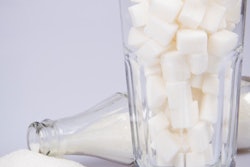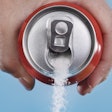
Added sugars have long-reaching effects that impact societal, oral, and systemic health. Part 1 of this series explored what counts as a sugary drink and the oral and systemic effects of drinking them. Part 2 focuses on how to counsel patients and activism initiatives.
Despite overwhelming evidence about the harms of added sugars, dentists don't always feel comfortable discussing nutrition with patients. So experts described the best strategies to counsel patients during a panel presentation at the recent 2018 Chicago Dental Society Midwinter Meeting.
The panel consisted of scientists, activists, clinicians, and professors with different areas of expertise. Together, they detailed how dentists can affect change on both an individual and societal level.
 Panelists from left to right: Poonam Jain, BDS, MPH; Julie Janssen, RDH; Sharon Clough, RDH; Elissa Bassler; and Charles LeHew, PhD.
Panelists from left to right: Poonam Jain, BDS, MPH; Julie Janssen, RDH; Sharon Clough, RDH; Elissa Bassler; and Charles LeHew, PhD."It's not easy," said Julie Janssen, RDH, from the division of oral health at the Illinois Department of Public Health. "It takes a long time, and it gives you all the more ammunition about drinking the tap water."
How can providers counsel patients?
In 2016, the ADA adopted a comprehensive policy on nutrition. The new policy encourages dentists to routinely counsel patients about healthy eating and supports the World Health Organization's added sugars recommendations, which suggest limiting added sugar consumption to approximately 6 teaspoons daily for adults. However, getting patients to understand and then follow these recommendations can be challenging.
"People have common misconceptions about sugar-sweetened beverages," said Elissa Bassler, CEO of the Illinois Public Health Institute, an activist organization that seeks to promote prevention and improve public health systems in the state.
For instance, some people believe that clear sodas are healthier than brown or colorful sodas, and others believe that fruit and sports drinks are healthy because of their names or packaging, Bassler noted.
“You need to know the science and also what resources you can send patients to.”
To help overcome these misconceptions, Sharon Clough, RDH, from the ADA Council on Advocacy for Access and Prevention, shared several tips on how to educate patients and ensure they're getting the message about the dangers of sugar-sweetened beverages and added sugars. First and foremost is to know the facts, she said.
"You need to know the science and also what resources you can send patients to," she said. "Know where you can find the answers and where they can find the answers for themselves."
Clough recommended the ADA's Mouth Healthy website, a consumer-focused educational portal that teaches about added sugars in plain language. The Rethink Your Drink campaign and the Kick the Can and Healthy Food America websites also are good resources, she noted.
When explaining the facts about added sugars, clinicians should strive to use plain, conversational language and comparisons, she added. This helps patients understand what you're saying in a way that relates to their everyday life.
"Talking to your patients about grams doesn't make sense to them," Clough said. "Teaspoons don't really do it either."
Instead, try illustrating how much sugar different drinks have by filling bottles with granulated sugar or sugar cubes. It can also be helpful to use comparison when talking about nutrition, she said. For instance, one can of soda has 200 calories, which would take 30 minutes to burn off by jogging on the treadmill.
Finally, limit the information you provide patients during a visit, so you don't overwhelm them. And have patients reiterate what you said to confirm their understanding.
"Take it slow and then summarize," Clough said. "They may not always get the answer right away, but that will prevent misunderstandings, and your outcomes will be much better."
What is happening with public activism?
Since sugar-sweetened beverage consumption is a large, public health problem, something must be done to address it, Bassler said. And while one-on-one counseling can greatly change an individual's life, it won't have broad, societal impact.
"We are not, one by one, going to solve the obesity problem or these oral health problems," she said, which is where public health activism comes in.
Bassler outlined three public policy movements designed to change behavior around added sugar consumption:
- Incentivize health food options and raise nutritional standards for those on public food assistance.
- Educate the public about sugar-sweetened beverages to reduce consumption.
- Add a 1 cent per ounce sugar-sweetened beverage tax and use the money for health purposes.
Perhaps the most talked about of these methods is the sugary drink tax, which has begun to sprout up in Mexico and a number of U.S. cities, including Berkeley, CA; Boulder, CO; Philadelphia; and Seattle. The passed soda tax bills tend to have some things in common, Bassler said. Notably, the tax revenue is used for a specific public health fund, and they are excise taxes, meaning the distributor, not the consumer, pays the tax.
"If it's built into the price on the shelf, then when I go to buy it, I see the difference between the water or diet soda and the sugar-sweetened beverage," Bassler said. "If you add it on at the end, people don't even know it's taxed."
Taxes on sugar-sweetened beverages are relatively new, but the early data look promising. Sugary drink purchases in Mexico have declined over time. And in Berkeley, sugar-sweetened beverage sales decreased 21%, compared with a 6% decrease in surrounding areas, Bassler said.
She also reiterated that broad, societal change takes time, equating the soda tax movement to cigarette taxes. But she is hopeful that individual and public efforts will work, and she noted that reducing sugar-sweetened beverage consumption is not impossible but inevitable.
"In policy, you're in it for the long haul because you're trying to change those big things at the bottom of the pyramid," she said. "It's inevitable, but it takes time. Three steps forward, two steps back. We'll get there."



















